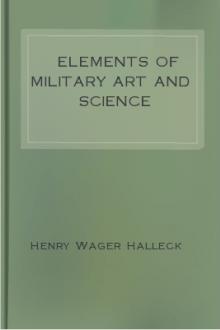Elements of Military Art and Science by Henry Wager Halleck (books you have to read txt) 📕

- Author: Henry Wager Halleck
- Performer: -
Book online «Elements of Military Art and Science by Henry Wager Halleck (books you have to read txt) 📕». Author Henry Wager Halleck
The measures resorted to in the attack and defence of the larger class of field-works, will necessarily partake much of the nature of the operations employed in the attack and defence of permanent fortifications.
II. The attack and defence of a fortress may be carried on either by a regular siege, or by irregular operations and an assault. The latter plan has sometimes been adopted when the works of the place were weak and improperly defended; where the time and means were wanting for conducting a regular siege; or where the assailants were ignorant of the means proper to be resorted to for the reduction of the fortress. Such operations, however, are usually attended by an immense sacrifice of human life, and the general who neglects to employ all the resources of the engineer's art in carrying on a siege, is justly chargeable with the lives of his men. In the siege of Cambrai, Louis XIV., on the solicitation of Du Metz, but contrary to the advice of Vauban, ordered the demi-lune to be taken by assault, instead of waiting for the result of a regular siege. The assault was made, but it was unsuccessful, and the French sustained great losses. The king now directed Vauban to take the demi-lune by regular approaches, which was done in a very short time, and with a loss of only five men! Again, at the siege of Ypres, the generals advised an assault before the breaches were ready. "You will gain a day by the assault," said Vauban, "but you will lose a thousand men." The king directed the regular works to be continued, and the next day the place was taken with but little loss to the besiegers.
But a work may be of such a character as to render it unnecessary to resort to all the works of attack which would be required for the reduction of a regular bastioned fort, on a horizontal site. For example: the nature of the ground may be such as to enable the troops to approach to the foot of the glacis, without erecting any works whatever; of course, all the works up to the third parallel may in this case be dispensed with without any violation of the rules of a siege. Again, the point of attack may be such that the other parts of the place will not flank the works of approach; here a single line of boyaux and short parallels may be all-sufficient.
But for the purpose of discussion, we will here suppose the place besieged to be a regular bastioned work on a horizontal site, (Fig.54.)
The operations of the siege may be divided into three distinct periods.
1st. The preliminary operations of the attack and defence previous to the opening of the trenches.
2d. The operations of the two parties from the opening of the trenches to the establishment of the third parallel.
3d. From the completion of the third parallel to the reduction of the place.
First period. The object of the investment of the place is to cut off all communication between the work and the exterior, thus preventing it from receiving succors, provisions, and military munitions, and also to facilitate a close reconnoissance of the place by the engineers, who should always accompany the investing corps, and pursue their labors under its protection. This corps should be composed chiefly of light troops—cavalry, light infantry, horse artillery, "brigades of engineers and mounted sappers,"—who march in advance of the besieging army, and, by a sudden movement, surround the work, seize upon all the avenues of approach, and carry off every thing without the work that can be of service either to the garrison or to the besiegers. To effect this object, the enterprise must be conducted with secrecy and dispatch.
The investing corps is now distributed around the work in the most favorable positions for cutting off all access to it, and also to prevent any communication with the exterior by detachments from the garrison, and even single individuals are sent out to give intelligence to a succoring army or to reconnoitre the operations of the besieging corps. These posts and sentinels, called the daily cordon, are placed some mile or mile and a half from the work, and beyond the reach of the guns. But in the night-time these posts are insufficient to accomplish their object, and consequently as soon as it is dark the troops move up as close to the work as possible without being exposed to the fire of musketry. This arrangement constitutes the nightly cordon.
By the time the main army arrives the reconnoissance will be sufficiently complete to enable the chief engineer to lay before the general the outline of his plan of attack, so as to establish the position of his dépôts and camp. These will be placed some two miles from the work, according to the nature of the ground. As they occupy a considerable extent of ground around the work, it will generally be necessary to form intrenchments strong enough to prevent succors of troops, provisions, &c., from being thrown into the place, and also to restrain the excursions of the garrison. The works thrown up between the camp and besieged place are termed the line of countervallation, and those on the exterior side of the camp form the line of circumvallation. These lines are generally about six hundred yards apart. It is not unusual in modern warfare to dispense with lines of circumvallation, (except a few detached works for covering the parks of the engineers and artillery,) and to hold the succoring army in check by means of an opposing force, called the army of observation.
The measures of defence resorted to by the garrison will, of course, be subordinate, in some degree, to those of attack. As soon as any danger of an investment is apprehended, the commanding general should collect into the place all the necessary provisions, forage, military munitions, &c., to be found in the surrounding country; all useless persons should be expelled from the garrison; a supply of timber for the works of the engineers and artillery, fascines, gabions, palisades, &c., prepared; all ground within cannon range around the work levelled; hedges and trees cut down; holes filled up; temporary buildings demolished or burnt; and all obstacles capable of covering an enemy and interrupting the fire of the work, removed.
During this period the engineer troops and working parties detached from the other arms will be most actively employed. As soon as the investing corps makes its appearance, bodies of light troops are thrown out to cut off reconnoitring parties, and, if possible, to draw the enemy into ambush. To facilitate these exterior operations, and to prevent a surprise, several guns of long range are placed on the salients of the bastions and demi-lunes, and others, loaded with grape, in the embrasures of the flanks, so as to sweep the ditches. About one-third of the garrison may be employed in exterior operations, and the other two-thirds in arranging the means of defence in the interior.
Second period.—As soon as the engineers have completed their reconnaissances and determined on the front of attack, and all the other preparations are made, the general will direct the opening of the trenches. The ground being previously marked out, battalions of light troops, termed guards of the trenches, as soon as it is dark, are placed about thirty yards in front of the first parallel, (A. Fig. 54,) with smaller sections, and sentinels about the same distance further in advance. These guards lie down, or otherwise conceal themselves from the fire of the work. The engineer troops and detachments of workmen being first marched to the dépôts and supplied with all the necessary tools for carrying on the work, now commence their labors under the protection of these guards. By daybreak the construction of the first parallel, and the trenches connecting it with the dépôts, will be sufficiently advanced to cover the men from the fire of the place; the guards will therefore be withdrawn, and the workmen continue their labors during the day to give the trenches the proper size and form.
The parallels are the long lines of trench which envelop the besieged work, and serve both as covered ways for the circulation of the besiegers, and as means of defence against sorties from the garrison; they are therefore arranged with banquettes for musketry fire. The boyaux are trenches run in a zigzag direction along the capitals of the front of attack, and are intended exclusively for the circulation of the troops; they have no banquettes. The first parallel is about six hundred yards from the place, and consequently beyond the reach of grape. It is constructed by the simple sap. After the first night, the guards, instead of advancing in front of the work, are placed in the trenches.
The second parallel (B) is made some three hundred or three hundred and fifty yards from the place, and being much exposed to grape, the flying-sap is employed in its construction. Batteries (H) are established between the first and second parallels to silence the fire of the demi-lunes of the collateral bastions, and others (I) near the second parallel, to enfilade the faces of the front of attack. These are armed in part with mortars and in part with heavy siege-pieces.
The works are now gradually pushed forward to the third parallel, (C), which is constructed about sixty yards from the salients of the place. As the operations of the besiegers are here greatly exposed to musketry fire, the trenches are constructed by the full-sap. The third parallel, having to contain the guards of the trenches, and being of less development than the two preceding, is made much wider. The second parallel now contains the reserve, and the first parallel becomes the dépôt of materials. Demi-parallels (G) are frequently established between the second and third, to be occupied by detachments of guards.
The operations of defence during this period are so directed as to harass the workmen in the trenches and retard the advance of the works of attack. Garrison pieces of long range and large howitzers are brought forward on the salients of the bastions and demi-lunes of attack, so as to fire in ricochet along the capitals on which the boyaux must be pushed: light and fire-balls are thrown out as soon as it becomes dark, to light up the ground occupied by the besiegers, thus exposing them to the fire of the work and to the attacks of the sortie parties. These parties are composed of light troops who charge the guards and compel the workmen to abandon their sapping tools and stand upon the defence. They are most effective when the besiegers commence the second parallel, as the guards in the first parallel are not so immediately at hand to protect the workmen. When the sortie detachment has driven these workmen from the trenches, instead of pursuing them into the first parallel, it will display itself in battle order to cover the engineer troops, (who should always accompany the detachment in this enterprise,) while they fill up the trenches and destroy the implements of the besiegers. When the guards of the trenches appear in force, the detachment will retire in such a way, if possible, as to draw the enemy within range of the grape and musketry of the collateral works. These sorties, if successful, may be frequently repeated, for they tend very much to prolong the siege. The best time for making them is an hour or two before day, when the workmen and





Comments (0)